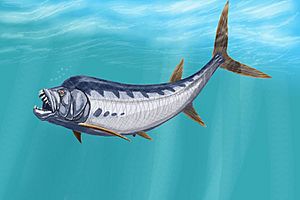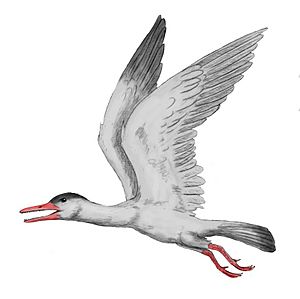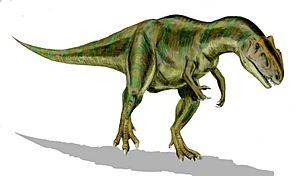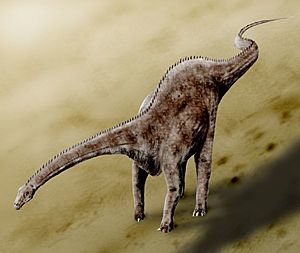Benjamin Franklin Mudge facts for kids
Quick facts for kids
Benjamin Franklin Mudge
|
|
|---|---|
 |
|
| 2nd Mayor of Lynn, Massachusetts 1st State Geologist of Kansas, 1864 |
|
| In office June 16, 1852 – April 4, 1853 |
|
| Preceded by | George Hood |
| Succeeded by | Daniel C. Baker |
| Personal details | |
| Born | August 11, 1817 Orrington, Maine |
| Died | November 21, 1879 (aged 62) Manhattan, Kansas |
| Spouse | Mary E. Beckford |
| Parents | James and Ruth Mudge |
| Occupation | Geologist, paleontologist, teacher, lawyer, chemist |
Benjamin Franklin Mudge (born August 11, 1817 – died November 21, 1879) was an American lawyer, geologist, and teacher. He was briefly the mayor of Lynn, Massachusetts. Later, he moved to Kansas and became the first official State Geologist there.
In 1864, he led the first geological survey of Kansas. This means he explored the state to map its rocks and minerals. He also wrote the first book about Kansas's geology. Mudge taught at the Kansas State Agricultural College (now Kansas State University) and gave many talks. He loved collecting fossils and was one of the first to explore ancient life in Kansas and the American West. He found many fossils in places like the Niobrara Chalk and the Morrison Formation.
Even though he wasn't formally trained in paleontology (the study of fossils), he kept excellent notes. He sent most of his fossils to famous paleontologists like Othniel Charles Marsh and Edward Drinker Cope. Mudge discovered at least 80 new kinds of extinct animals and plants. His finds are now in major museums like the Smithsonian and Yale's Peabody Museum of Natural History. One of his most famous discoveries was the first "bird with teeth," called Ichthyornis. He also helped discover the dinosaurs Diplodocus and Allosaurus.
Contents
Benjamin Franklin Mudge's Life
Early Years and Education
Benjamin Franklin Mudge was born in Orrington, Maine, on August 11, 1817. His family moved to Lynn, Massachusetts, in 1818. He worked as a shoemaker for six years to help his older brothers with their church studies.
After that, he went to Wesleyan University. Unlike his brothers, who became religious leaders, Benjamin studied science. He graduated in 1840 and later earned his Master of Arts degree. In 1842, he became a lawyer. He married Mary E. Beckford on September 16, 1842. In 1852, he was elected mayor of Lynn, Massachusetts. He ran on a platform that aimed to reduce alcohol use.
In 1859, Mudge moved to Cloverport, Kentucky. There, he worked briefly as a chemist at an oil refinery.
Teaching and State Geology
When the American Civil War began in 1861, Mudge moved to Quindaro, Kansas. He became a public school teacher in Kansas City. In Quindaro, Mudge and his family helped people seeking freedom from slavery.
He traveled around Kansas, giving talks about geology. In 1864, he gave a series of lectures to the state legislature in Topeka. This happened while lawmakers were discussing a bill to create the first state geological survey. The Topeka Tribune newspaper reported that his lectures were very popular.
Mudge was then chosen to be the first State Geologist of Kansas. He was also made the director of the first Kansas Geological Survey. He accepted the job, even though he had preferred someone else for the role.
His job was to explore about 212,000 square kilometers of Kansas. He needed to find out about the state's mineral and soil resources. He had a budget of $3,500 and a team of five people. In the 1860s, there were not many railroads or towns in western Kansas. Mudge moved to Manhattan, Kansas. Even though he couldn't visit every part of the state, he finished his report, Geology of Kansas, by November 30, 1864. This was the first book ever written about Kansas geology. It focused on important resources like coal and salt.
Mudge left the position after his term. The 1864 and 1865 reports were not published until 1866 due to money problems. The Kansas Geologic Survey stopped for a while after that. It was permanently started again in 1895 at the University of Kansas.
After being State Geologist, Mudge became a professor at the Kansas State Agricultural College (KSAC). He taught Natural Sciences starting in 1865. He left KSAC in 1873 after a disagreement about his pay.
Amazing Fossil Discoveries
Mudge started going on field expeditions to find fossils in 1865, while still teaching at KSAC. He found footprints near Junction City in 1865. In 1866, he found leaves from the Late Cretaceous period near Ellsworth. He found more plants and a reptile in 1869 near the Republican River.
-
Edward Drinker Cope, a famous paleontologist.
-
Othniel Charles Marsh, another leading paleontologist.
-
Louis Agassiz, a well-known naturalist.
-
James Dwight Dana, a geologist and mineralogist.
His 1870 trip near Fort Wallace led to many discoveries of plesiosaurs and fish. In 1871, he found plants, shells, and the bird Hesperornis in western Kansas. He continued to find new species in different Kansas counties in 1872, 1873, and 1874.
Mudge kept a small collection of fossils at KSAC. But he sent most of his amazing finds to paleontologists in the Eastern U.S. so they could study and describe them. He worked with scientists like Fielding Bradford Meek at the Smithsonian and Leo Lesquereux (for plants). He also sent fossils to Edward Drinker Cope in Philadelphia and Othniel Charles Marsh at Yale. Cope, Marsh, and Lesquereux all visited Mudge in Kansas. Cope and Lesquereux published most of Mudge's early discoveries.
In 1872, Mudge discovered Ichthyornis. He first planned to send it to Cope, but then heard of Marsh's interest and sent it to him instead. Marsh described the bird in 1872. This was the first bird ever described that had teeth! Before this, scientists thought birds like Archaeopteryx had beaks, not teeth. This discovery also marked the beginning of Mudge's work with Marsh. At this time, a famous rivalry between Cope and Marsh, known as the "Bone Wars," was heating up.
Working for Marsh
After Mudge left KSAC in 1874, he wrote to Marsh. Marsh then hired Mudge to lead fossil hunting trips. Samuel Wendell Williston helped Mudge on his 1874 trip and later led his own expeditions. From 1874 to 1876, Mudge mainly searched for fossils in the Kansas Chalk. From 1876 to 1879, he explored Colorado. There, he found some of the first Jurassic dinosaurs in the American West. He once shipped over three tons of fossils to Yale!
Marsh's rival, Cope, also had teams looking for fossils. In 1877, Cope's team was making big discoveries in Wyoming and Colorado. Marsh sent Mudge to find a new fossil site nearby. Even though the site was later closed because the bones were too fragile, Mudge and Williston made important discoveries there in 1877. They found the first Allosaurus and Diplodocus dinosaurs. Marsh later named both of these species.
Benjamin Mudge's Lasting Impact
Many people remember Benjamin F. Mudge as a great scientific explorer. In 1867, Mudge and John D. Parker started the Kansas Natural History Society. This group later became the Kansas Academy of Science in 1871. Mudge was its first president and published many of his scientific papers in its journal. In 1878, he became a fellow of the American Association for the Advancement of Science. He passed away on November 21, 1879, and was buried two days later.

Three different species were named in Mudge's honor. In 1871, Cope named a mosasaur (a large marine reptile) species Liodon mudgei. Lesquereux also named a species of oak tree Quercus mudgeii in 1872. Mudge himself named a part of the Niobrara Formation in 1876.
During his career, Mudge discovered many amazing fossils. These included mosasaurs and plesiosaurs (both marine reptiles). He also found Late Cretaceous leaves, various reptiles, and many types of fish like Xiphactinus. He found molluscs and trace fossils, which are signs of ancient life like gastroliths (stomach stones) and Pennsylvanian footprints. He discovered more than 80 new species. Over 300 of his fossil specimens are now in the Peabody Museum at Yale.
Mudge's Beliefs and Character
Mudge was part of groups that wanted to limit alcohol use. As mayor of Lynn, he closed many saloons. In Kentucky and later in Kansas, he was known for being against slavery. During the Civil War, he helped people seeking freedom from slavery. He protected them even when his own home and life were threatened.
He was very interested in natural history. His student, Williston, wrote in 1898 that Mudge was very excited about his discoveries. Mudge was very organized. He kept excellent records of where he found his fossils and details about the specimens themselves. Scientists today still praise his careful work and detailed field notes.
Images for kids









